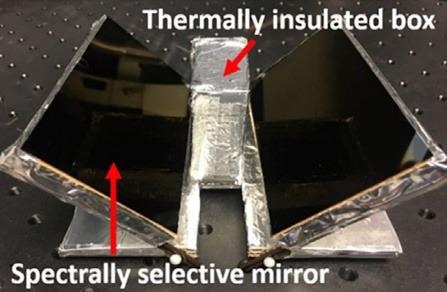Feb 9 2021
Passive cooling is similar to the shade provided by trees, and this phenomenon has been around all the time.

Image Credit: University at Buffalo.
Lately, scientists have been investigating how a passive cooling technique—called sky or radiative cooling—can be turbo-charged with sun-blocking nanomaterials that remove heat away from the rooftops of buildings.
Although advances have been made, this environmentally friendly technology is not an ordinary thing, because investigators have struggled to increase the cooling capabilities of materials.
A new study, headed by engineers from the University at Buffalo (UB), has made considerable advancement in this field. Published in the Cell Reports Physical Science journal on February 8th, 2020, the study explains an exclusively designed radiative cooling system that:
- Decreased the temperature of the test box in laboratory settings, intended to replicate the night, by over 14°C (25°F)
- Decreased the temperature within a test system in an outdoor surrounding under direct sunlight by over 12°C (22°F)
- Concurrently captured sufficient solar power that could be utilized to heat water to around 60°C (140°F)
Although the system tested was just 70 cm2 (27.5″), it could ultimately be upgraded to cover the building rooftops, stated the engineers. The goal is to decrease society’s dependence on fossil fuels for heating and cooling purposes. The system could also help communities that have only limited access to electricity.
“There is a great need for heating and cooling in our daily life, especially cooling in the warming world,” stated the Qiaoqiang Gan, PhD, the lead author of the study and a professor of electrical engineering in the School of Engineering and Applied Sciences at UB.
The researchers include Zongfu Yu, PhD, from the University of Wisconsin-Madison; Boon Ooi, PhD, from the King Abdullah University of Science and Technology (KAUST) in Saudi Arabia; and also members of Gan’s laboratory at UB, and Ooi’s laboratory at KAUST.
System Design and Materials Key to Success
The new system essentially includes a couple of mirrors, composed of 10 very thin layers of silicon dioxide and silver, which are positioned in a V-shape pattern. Both mirrors absorb the incoming solar light and convert the solar power from near-infrared and visible waves into heat.
The mirrors reflect the mid-infrared waves from an 'emitter' (that is, a vertical box placed between both mirrors), which subsequently reflects the heat they carry into the sky.
Since the thermal emission from both surfaces of the central thermal emitter is reflected to the sky, the local cooling power density on this emitter is doubled, resulting in a record high-temperature reduction.
Qiaoqiang Gan, PhD, Study Lead Author and Professor of Electrical Engineering, School of Engineering and Applied Sciences, University at Buffalo
Gan added, “Most radiative cooling systems scatter the solar energy, which limits the system’s cooling capabilities. Even with a perfect spectral selection, the upper limit for the cooling power with an ambient temperature of 25 degrees Celsius is about 160 watts per square meter. In contrast, the solar energy of about 1000 watts per square meter on top of those systems was simply wasted.”
Spinoff Company Aims to Commercialize Technology
Gan has also co-founded a spinoff company, called Sunny Clean Water LLC, which is looking for associates to market the new technology.
One of the key innovations of our system is the ability to separate and retain the solar heating and radiative cooling at different components in a single system. During the night, radiative cooling is easy because we don’t have solar input, so thermal emissions just go out and we realize radiative cooling easily. But daytime cooling is a challenge because the sun is shining. In this situation, you need to find strategies to separate solar heating from the cooling area.
Lyu Zhou, Study Co-First Author and PhD Candidate in Electrical Engineering, School of Engineering and Applied Sciences, University at Buffalo
The study is based on prior research works, headed by Gan’s laboratory, in which a cone-shaped system was created to provide electricity-free cooling in highly populated cities to acclimatize to climate change.
The new double-sided architecture realized a record local cooling power density beyond 280 watts per square meter. Under standard atmospheric pressure with no vacuum thermal isolation, we realized a temperature reduction of 14.5 degrees Celsius below the ambient temperature in a laboratory environment, and over 12 degrees Celsius in an outdoor test using a simple experimental system.
Haomin Song, PhD, Study Co-First Author and Research Assistant Professor of Electrical Engineering, School of Engineering and Applied Sciences, University at Buffalo
“Importantly, our system does not simply waste the solar input energy. Instead, the solar energy is absorbed by the solar spectral selective mirrors, and it can be used for solar water heating, which is widely used as an energy-efficient device in developing countries. It can retain both the solar heating and radiative cooling effects in a single system with no need of electricity. It’s really sort of a ‘magic’ system of ice and fire,” Gan concluded.
The researchers will continue to explore new ways to enhance the novel technology, including the analysis of how to sufficiently capture solar energy to boil water, rendering it appropriate for drinking purposes.
The study was funded by the Thermal Transport Processes program of the U.S. National Science Foundation.
Journal Reference:
Zhou, L., et al. (2021) Hybrid concentrated radiative cooling and solar heating in a single system. Cell Reports Physical Science. doi.org/10.1016/j.xcrp.2021.100338.